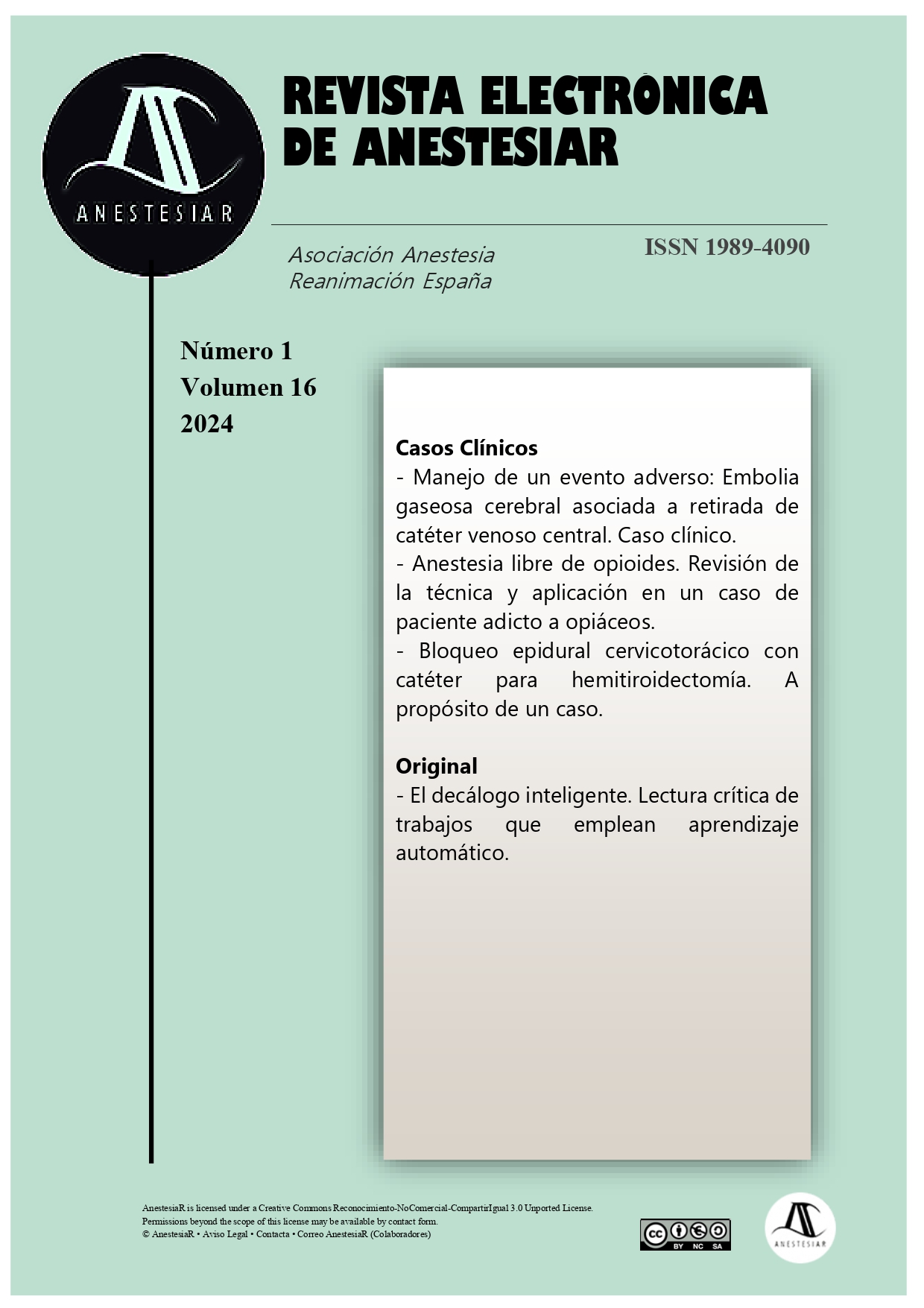Opioid-free anesthesia. Review of the technique and application in a case of a patient addicted to opiates.
DOI:
https://doi.org/10.30445/rear.v16i1.1183Keywords:
opioid-free anesthesia, OFA, analgesia, surgery, adverse effect, pain, opioid disorderAbstract
INTRODUCTION: Opioids are the classic basis of intraoperative analgesia, but they have known undesirable effects: nausea, vomiting, sedation, ileus, respiratory depression, hyperalgesia, tolerance, chronic postoperative pain, addiction... Opioid-free anesthesia is based on using Ketamine. , Dexmedetomidine, Lidocaine and other adjuvant drugs such as NSAIDs, corticosteroids, magnesium, hypotensives, together with regional blocks managed with local anesthetics, to achieve multimodal anesthesia that replaces opioids as much as possible.
METHOD: We present a case of a patient chronically addicted to opiates, who underwent a laparotomy for abdominoperineal amputation. Initially, a lumbar epidural catheter was placed through which bolus 0.25% levobupivacaine was administered during the intraoperative period. In addition, the patient was successfully managed with the protocol that we describe in the article, using a mixture of drugs as preemptive analgesia, before the surgical incision, in order to prevent CNS sensitization to pain; It consists of NSAIDs, Dexamethasone and magnesium sulfate. Subsequently, during anesthetic induction and maintenance, a mixture of Lidocaine, Dexmedetomidine and Ketamine is administered at low doses, together with the usual doses of Propofol and relaxation with Rocuronium.
RESULT: OFA allowed adequate anesthetic management, with optimal hemodynamic stability and no notable side effects.
CONCLUSION: OFA is a very adequate alternative in the anesthetic management of patients addicted to opioids, achieving excellent results. Extensive familiarization of the anesthesiologist with the pharmacology of the various formulas used is required, as well as their protocolization.
KEYWORDS: opioid-free anesthesia, OFA, analgesia, surgery, adverse effect, pain, opioid disorder.
References
- Sultana A TDSR. Special indications for Opioid Free Anaesthesia and Analgesia, patient and procedure related: including obesity, sleep apnoea, chronic obstructive pulmonary disease, complex regional pain syndromes, opioid addiction and cancer surgery. Best Practice & Research Clinical Anaesthesiology. 2017;(31): p. 547-560.
- Pérez S PATJUMC. Alergia a opioides y Cirugía de resección pulmonar. Uso de dexmedetomidina y ketamina como parte de un abordaje multimodal. Revista Española de Anestesiologia y Reanimación. 2021; 68: p. 171-173.
- Salomé A HHFDMV. Opioid-Free Anesthesia Benefit-Risk Balance: a Systematic Review and Meta-Analysis of Randomized Controlled Trials. Journal of Clinical Medicine. 2021; 10(2069).
- Brown M BTBRWKMJ. Perioperative Pain Management for Surgical Patients with opioid use disorder: a program development initiative. Journal of PeriAnesthesia Nursing. 2021;(36): p. 622-628.
- Scholzen E ZASC. Perioperative Management and Analgesia for Patients Taking Buprenorphine and Other Forms of Medication-Assisted Treatment for Substance Abuse Disorders. Advances in Anesthesia. 2019;(37): p. 65-86.
- Pozek JP GSBJSE. Practical Management of the Opioid-Tolerant Patient in the Perioperative Surgical Home. Advances in Anesthesia. 2017; 35(1): p. 175-190.
- Toleska M KBKASMNJDATN. Opioid Free Anesthesia for Laparotomic Hemicolectomy. A case report. Pril (Makedon Akad Nauk Umet Odd Med Nauki). 2018; 39(2-3): p. 121-126.
- Gil Martín A MGMSRFJMGT. Hiperalgesia asociada al tratamiento con opioides. Dolor. 2014; 21(5).
- Olausson A SCAPJPTSEWA. Total opioid-free general anaesthesia can improve postoperative outcomes after surgery, without evidence of adverse effects on patient safety and pain management: A systematic revies and meta-analysis. Acta Anaesthesiologica Scandinavica. 2022; 66(2): p. 170-185.
- Loveridge R PS. Systemic non-opioid adjuvant analgesics: Their role in acute postoperative pain in adults. Trends in Anaesthesia and Critical Care. 2014; 4(1): p. 10-18.
- Garcia JL MTVORAICVDLSFGMCJ. Uso de ondansetrón vs lidocaína para la prevención del dolor asociado a la administración de propofol durante la inducción anestésica. An Med Asoc Med Hosp ABC. 2012; 57(3): p. 210-216.
- Tauste-Hernández B CSMFGFELJ. Review of binary, ternary and quaternary mixtures for induction and maintenance of opioid free anesthesia. Farmacia Hospitalaria. 2021; 45(3): p. 135-141.
- Toleska M DA. Is an opioid-free anaesthesia possible without using alpha-2 agonists? Indian Journal of Anaesthesia. 2020; 64(5): p. 428-431.
Downloads
Published
How to Cite
Issue
Section
License
Copyright (c) 2024 Revista Electrónica AnestesiaR

This work is licensed under a Creative Commons Attribution-ShareAlike 4.0 International License.
 Envío y derechos de autor
Envío y derechos de autor


 Revista Electrónica AnestesiaR by
Revista Electrónica AnestesiaR by 